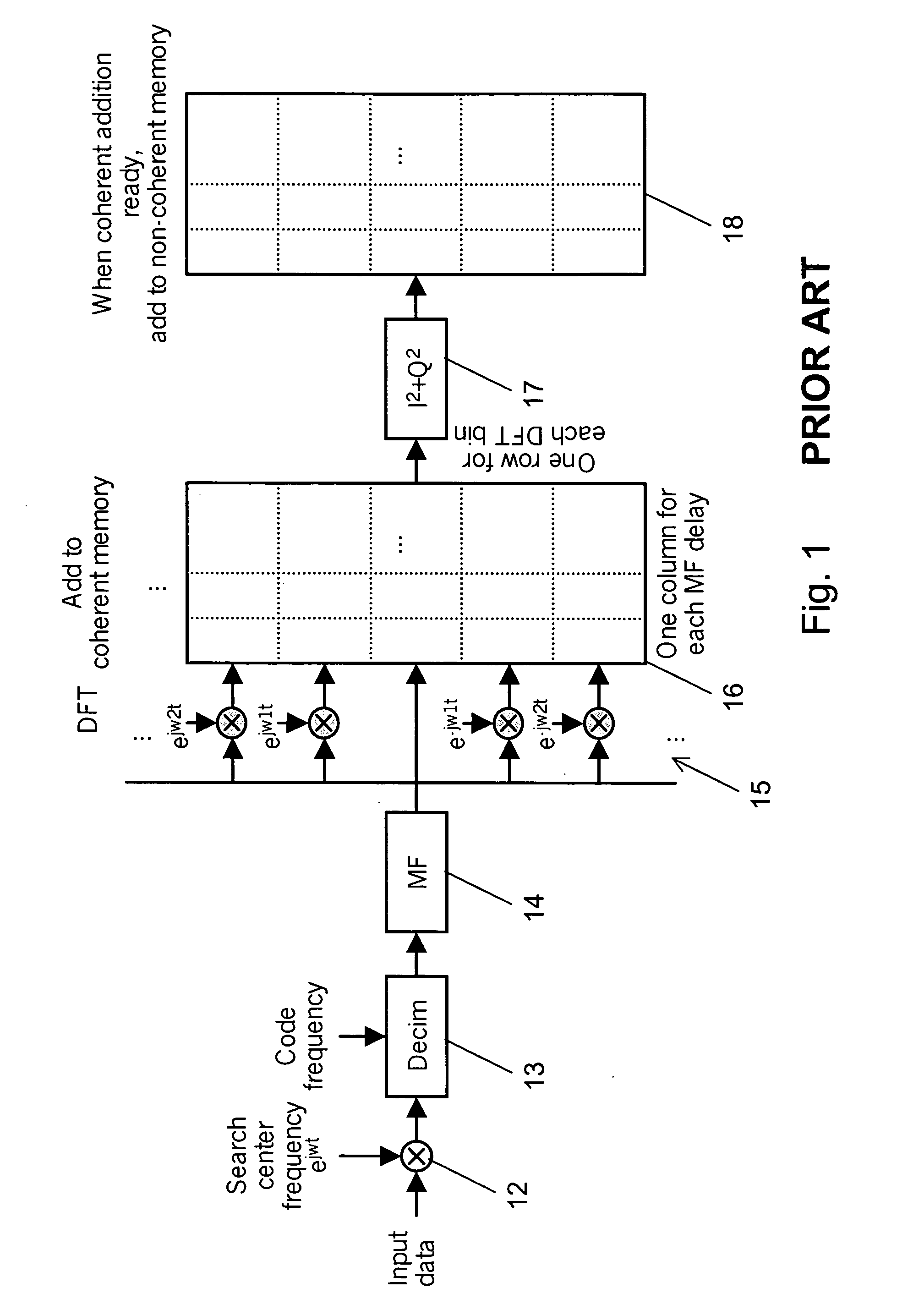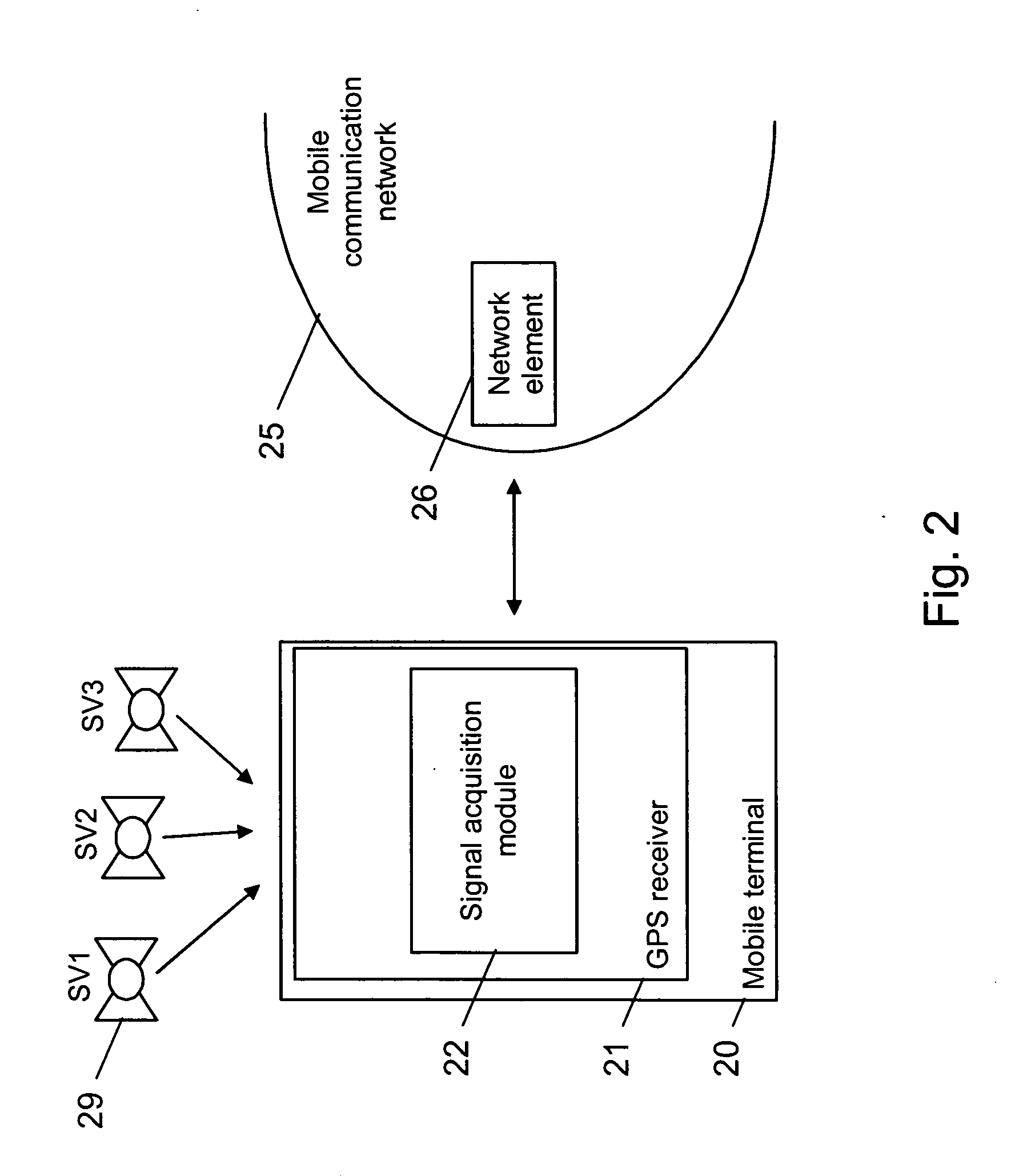Determination of a code phase
a code phase and phase determination technology, applied in the field ofsignal acquisition modules, can solve the problems of code doppler compensation no longer correct, dft bank b>15/b> cannot check the whole uncertainty range, and may be so large in the combined uncertainty range, so as to improve the sensitivity of the architecture, prolong the integration time, and increase the frequency uncertainty
- Summary
- Abstract
- Description
- Claims
- Application Information
AI Technical Summary
Benefits of technology
Problems solved by technology
Method used
Image
Examples
first embodiment
[0064] the signal acquisition module 22 according to the invention is presented in FIG. 3. It is a modification of the known signal acquisition module presented with reference to FIG. 1.
[0065] The signal acquisition module 22 comprises again a mixer and a decimation block (not shown), a matched filter 14, a DFT bank 15 and a coherent memory 16. The coherent memory 16 is structured again in the form of a table which comprises one column for a respective code phase bin and one row for a respective DFT bin. The signal acquisition module 22 also comprises a non-coherent memory 18, which is structured again in the same way as the coherent memory 16.
[0066] In contrast to FIG. 1, however, a mapping component 30 is inserted between the coherent memory 16 and the non-coherent memory. The function of the processing component 17 of the signal acquisition module of FIG. 1 is integrated by way of example in this mapping component 30.
[0067] The mapping component 30 comprises in addition a porti...
second embodiment
[0100]FIG. 9 presents the signal acquisition module 22 of the GPS receiver 21 in FIG. 2. Also this embodiment is a modification of the signal acquisition module presented with reference to FIG. 1.
[0101] The signal acquisition module 22 comprises a mixer and a decimation block (not shown), a matched filter 14, a DFT bank 15, a coherent memory 16, a processing component 17 and a non-coherent memory 18. Both memories 16, 18 are structured in the same way as the memories 16, 18 in FIGS. 1 and 3.
[0102] In contrast to FIG. 1, however, a mapping component 90 is inserted between the DFT bank 15 and the coherent memory 16. The mapping component 90 realizes a code Doppler compensation and a carrier Doppler drift compensation.
[0103] The operation of this signal acquisition module 22 is the same as illustrated in FIG. 4, except that the order of processing is changed. More specifically, the code Doppler compensation in step 408 and the possible carrier Doppler drift compensation in step 409 a...
fourth embodiment
[0106]FIG. 10 presents a third and fourth embodiment of the signal acquisition module 22 of the GPS receiver 21 in FIG. 2. Also these embodiments are modifications of the signal acquisition module presented with reference to FIG. 1.
[0107] The signal acquisition module 22 comprises again a mixer and a decimation block (not shown), a matched filter 14, a DFT bank 15, a coherent memory 16, a processing component 17 and a non-coherent memory 18. Both memories 16, 18 are structured in the same way as the memories 16, 18 in FIG. 1.
[0108] In contrast to FIG. 1, however, a mapping component 100 has access either to the coherent memory 16 or to the non-coherent memory 18, the latter alternative being indicated in FIG. 10 by dashed lines. The mapping component 100 realizes a code Doppler compensation and a carrier Doppler drift compensation in accordance with the invention.
[0109] If the mapping component 100 has access to the coherent memory 16, the operation of the signal acquisition modul...
PUM
 Login to View More
Login to View More Abstract
Description
Claims
Application Information
 Login to View More
Login to View More - R&D
- Intellectual Property
- Life Sciences
- Materials
- Tech Scout
- Unparalleled Data Quality
- Higher Quality Content
- 60% Fewer Hallucinations
Browse by: Latest US Patents, China's latest patents, Technical Efficacy Thesaurus, Application Domain, Technology Topic, Popular Technical Reports.
© 2025 PatSnap. All rights reserved.Legal|Privacy policy|Modern Slavery Act Transparency Statement|Sitemap|About US| Contact US: help@patsnap.com



